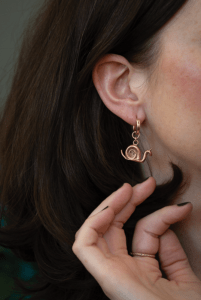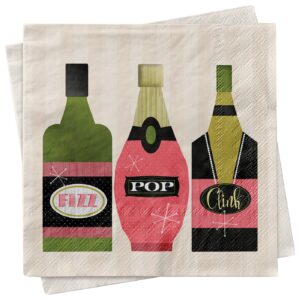Distinctly American
Creating his products in a workshop off of a dirt road in Embden, Maine, LeHay believes American consumers have started to have their fill of throwaway items. “They are moving back to a lifestyle that appreciates quality products that benefit the local economy, honors local history and is mindful of the environment,” LeHay pointed out.
Peter and Robin Morris, co-owners of Creations in Copper by Dos Damas Designs in Phoenix, Arizona also incorporate locally mined copper in their designs that incorporate themes from the Southwest such as the Kachina dancers, roadrunners and coyotes.
It is this synergy — between local and handmade — that is finding new momentum and fueling growth in a sector that was once on shaky ground. All across the United States, artisans and crafters and sculptors are working with a wide variety of materials, often locally sourced, and delivering high design and functionality. Jerry Kermode is a wood-turner who crafts upscale bowls, wood corks and oil lamps from woods sourced in and around California where he works. “We use primarily old growth redwood stumpage which we buy from reliable companies here in Northern California,” said his wife Deborah Kermode, “This tree grows only along this coast and up into southern Oregon. When the redwood forests were so decimated by logging, they left huge, tall stumps, which are now being harvested from private lands. Our other favorite is California big leaf maple burl, again purchased from reliable sources.”
Melanie Feerst, who handcrafts jewelry using her background as a sculptor, Minnesota-based Kerry Brooks who wholesales ceramics with metals and glasses mixed in. Patti Gay, who works her autistic son Noah’s hand-drawn creations into works of art — these are but a few of the many artists who are delivering on the promise of handmade using an unusual variety of materials. Lauren Renfrow from Times Two Design, for example, uses antlers that are naturally shed from whitetail deer in Montana, for the company’s lacquered trays with antlers.
For Renfrow, no natural material is off-limits. Her first design was a lamp made of quartz points, then came her agate-topped boxes in an array of jewel tones. Wood, barnacles, bark and antlers all find a place in her home accessories collection, all handmade in her Dallas studio.
The maker movement revolution
These are items, says woodworker Collin Garrity, that consumers want to use every day: “They’re more like your favorite pair of pants than a ball gown, they buy the pieces they feel really good about, the ones they’ll want to use and look at every day.” Garrity, who wholesales a line of kitchen and office goods and jewelry all handcrafted with quality woods in his St. Louis studio, says that the maker movement has put a whole new way of looking at the fine line between art and function.
“The younger generations grew up in houses with curios and collectibles in cupboards and mantelpieces — and now they’d rather have them on their desks. They want to collect things that they also use,” Garrity says. The Web, he adds, has changed the dynamics so that consumers are now exposed to the beauty of handmade goods. “The Internet is a lifestyle guide for younger generations. Things aren’t desirable simply because they are handmade, but because they are handmade well.”
Melanie Feerst, who creates a variety of mixed-media jewelry pieces bringing her aesthetic as a sculptor to the craft, agrees that the maker movement has lead to an increased awareness of manufacturing processes including “small batch, user-centered design that focuses on the process of creation — from iteration to collaborative building, often using digital technologies like 3-D printing or laser cutting.”
“The disciplines of art, design and craft are blurring — architects are designing products, designers are building sculpture and sculptors are creating jewelry.” And while some artisans like John Guptil, whose Portland, Maine-based company CHART Metalworks, creates jewelry with a personal touch, believe that the marketplace is skewing more toward hip and high-end design, there are others like LeHay who see a market for crafts across the spectrum with the popularity of American handmade being a “rising tide that raises all ships.”

Value proposition
Even if many handmade goods are understandably more expensive than mass-produced equivalents, customers often appreciate the craftsmanship that goes into each piece. “Objects that you connect with emotionally make you feel good when you’re wearing or using them, whether you develop attachment through the narrative, imagery or material. The added bonus is by purchasing handmade you are supporting the artisan who made the piece with love, passion and mindful attention,” Feerst points out.
Kermode, whose bowls retail between $250 to $600, gets comments from “how can you charge so much?” to “these are museum-quality and should cost more.”

We price according to the market and in a way that honors the wood and the workmanship,” Deborah Kermode said. It is at times like these that customer education is key. The Kermodes include a 23-minute DVD that shows the entire production process they share with the galleries that sell their high-end products. Gay strongly believes in story cards to drive home the message of her products. “PaperProducts Design has a wonderful little card that retailers put out with our products. I hear from people all over the world that now know our story and have purchased products with Two Can Art designs. I feel like each of them is now a part of our story too,” she says.

Heather LaPorte Arata, owner of Earth and State, an eclectic gift shop in Media, Pennsylvania, stocks a variety of functional pottery in her shop, including her husband Drew’s work. “In our store we know where everything is made. The artists who make our items have become our friends. We can tell you who they are, where they live, even what kind of pets they have,” Arata said. “Our goal is to create a connection between the consumer and the producer of our products. We want you to leave here feeling that you are a part of a greater picture, that the choices you make when purchasing a product really makes a difference.”
Back to the future
The popularity of the DIY movement, the resurgence of the American economy and the increasing realization of the power of buying local are all working in tandem to drive growth for distinctly American handcrafted goods. “Social media has opened up a multitude of opportunities,” LeHay says, “What I like about all these sites is that it allows customers to ‘see’ inside my workshop. Since my work has a multitude of steps in its creation it’s helpful for customers to see the work that goes into each piece. Once they see behind the scenes, they are better able to appreciate the time and effort that goes into each item.”
Garrity likens the marketplace to shopping for pizza. “I think about products in terms of pizza — there’s a time for spending the whole afternoon making my own dough and sauce — and making my own pizza — which will look like a mess, taste alright and be hugely satisfying. There’s a time for frozen pizza, there’s a time for delivery, and there’s a time to go to a restaurant where there’s someone in the kitchen who’s dedicated their life to making the best, freshest, and most memorable pizza they can,” Garrity said. “To stretch the metaphor — there’s a time for all kinds of products — the mug your niece made in high school ceramics class, to-go cups, dish set mugs — and the mugs you bought at the potter’s farmer’s market table. It’s important to know the difference — and to know the value of each,” he adds.
“‘Made in America’ is only a statement of high quality as long as that’s what consumers want it to be, and the idea that we ‘vote’ every time we buy something holds truth.”











